中国书画英文版
- 格式:pptx
- 大小:7.00 MB
- 文档页数:17
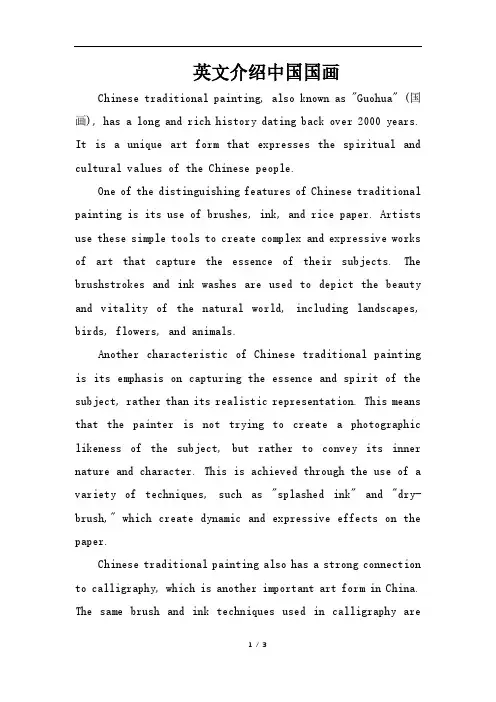
英文介绍中国国画Chinese traditional painting, also known as "Guohua" (国画), has a long and rich history dating back over 2000 years. It is a unique art form that expresses the spiritual and cultural values of the Chinese people.One of the distinguishing features of Chinese traditional painting is its use of brushes, ink, and rice paper. Artists use these simple tools to create complex and expressive works of art that capture the essence of their subjects. The brushstrokes and ink washes are used to depict the beauty and vitality of the natural world, including landscapes, birds, flowers, and animals.Another characteristic of Chinese traditional painting is its emphasis on capturing the essence and spirit of the subject, rather than its realistic representation. This means that the painter is not trying to create a photographic likeness of the subject, but rather to convey its inner nature and character. This is achieved through the use of a variety of techniques, such as "splashed ink" and "dry-brush," which create dynamic and expressive effects on the paper.Chinese traditional painting also has a strong connection to calligraphy, which is another important art form in China. The same brush and ink techniques used in calligraphy arealso used in painting, creating a natural synergy between the two forms of art.Finally, Chinese traditional painting is deeply rooted in Chinese culture and philosophy. It reflects the Taoist and Buddhist beliefs of harmony, balance, and tranquility, as well as Confucian values of respect for tradition and authority. The paintings often feature Chinese poetry and calligraphy as well, which adds a further layer of meaning and cultural richness to the art form.In conclusion, Chinese traditional painting is a unique and beautiful art form that reflects the rich cultural heritage of China. It is characterized by its use of simple materials and techniques, its focus on capturing the essence of the subject, and its deep connection to Chinese culture and philosophy.以下为上述内容的中文翻译:中国传统画,也被称为“国画”,有着悠久而丰富的历史,可以追溯到两千多年前。
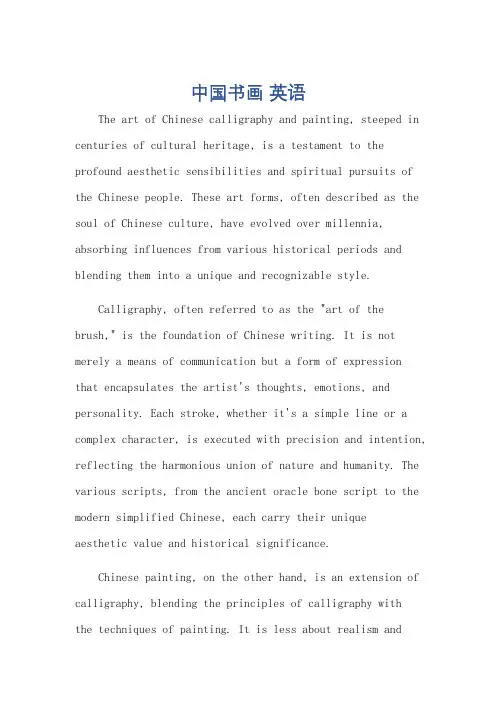
中国书画英语The art of Chinese calligraphy and painting, steeped in centuries of cultural heritage, is a testament to the profound aesthetic sensibilities and spiritual pursuits of the Chinese people. These art forms, often described as the soul of Chinese culture, have evolved over millennia, absorbing influences from various historical periods and blending them into a unique and recognizable style.Calligraphy, often referred to as the "art of the brush," is the foundation of Chinese writing. It is not merely a means of communication but a form of expressionthat encapsulates the artist's thoughts, emotions, and personality. Each stroke, whether it's a simple line or a complex character, is executed with precision and intention, reflecting the harmonious union of nature and humanity. The various scripts, from the ancient oracle bone script to the modern simplified Chinese, each carry their uniqueaesthetic value and historical significance.Chinese painting, on the other hand, is an extension of calligraphy, blending the principles of calligraphy withthe techniques of painting. It is less about realism andmore about expressing the artist's inner world and their understanding of nature and life. Whether it's the serene landscapes, vibrant flower and bird paintings, or the abstract ink washes, Chinese painting embodies the principles of simplicity, spontaneity, and harmony.In recent years, the global interest in Chinese calligraphy and painting has been on the rise. Many foreigners have been drawn to these art forms, fascinated by their unique aesthetic appeal and profound cultural connotations. International exhibitions and art festivals dedicated to Chinese calligraphy and painting have become commonplace, providing a platform for artists from around the world to showcase their talents and exchange ideas.The integration of Chinese calligraphy and paintinginto the global art scene is not just about promoting cultural exchange but also about fostering mutual understanding and respect. As these art forms traverse cultural barriers, they serve as powerful bridges that connect people from different parts of the world, fostering a deeper understanding of Chinese culture and art.Moreover, the popularity of Chinese calligraphy and painting among foreigners has given rise to a new breed of artists who are blending traditional Chinese techniques with contemporary elements, creating a unique and innovative style that resonates with a global audience. This fusion of old and new, East and West, not only showcases the adaptability and vitality of Chinese art but also demonstrates its relevance and appeal in the modern world.In conclusion, the art of Chinese calligraphy and painting is not just a visual treat but a profound expression of Chinese culture and philosophy. Its global recognition and appreciation are testament to the enduring charm of Chinese art and its ability to transcend cultural and linguistic boundaries, connecting people from all corners of the world through the universal language of art. **中国书画在英语世界中的辉煌**中国书画,这门沉浸在数百年文化遗产中的艺术,是中国人民深刻的美学敏感性和精神追求的见证。
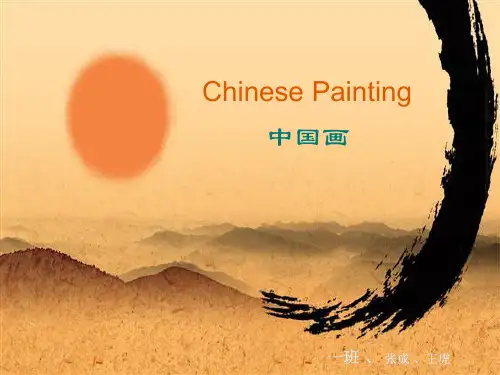
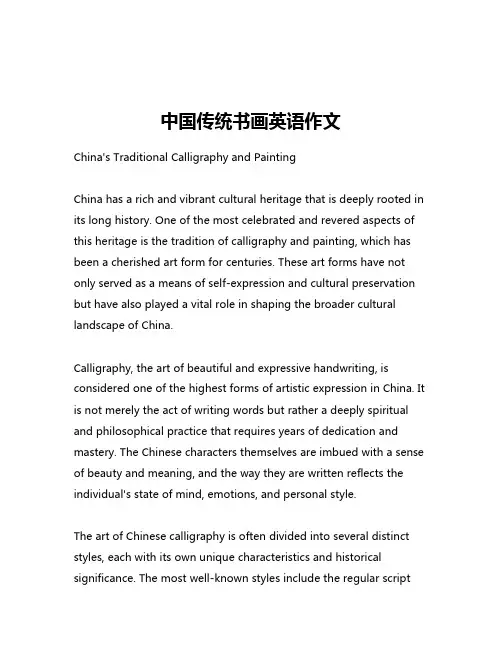
中国传统书画英语作文China's Traditional Calligraphy and PaintingChina has a rich and vibrant cultural heritage that is deeply rooted in its long history. One of the most celebrated and revered aspects of this heritage is the tradition of calligraphy and painting, which has been a cherished art form for centuries. These art forms have not only served as a means of self-expression and cultural preservation but have also played a vital role in shaping the broader cultural landscape of China.Calligraphy, the art of beautiful and expressive handwriting, is considered one of the highest forms of artistic expression in China. It is not merely the act of writing words but rather a deeply spiritual and philosophical practice that requires years of dedication and mastery. The Chinese characters themselves are imbued with a sense of beauty and meaning, and the way they are written reflects the individual's state of mind, emotions, and personal style.The art of Chinese calligraphy is often divided into several distinct styles, each with its own unique characteristics and historical significance. The most well-known styles include the regular script(kaishu), the cursive script (xingshu), the running script (caoshu), and the seal script (zhuan). Each of these styles has its own set of brushstrokes, rhythms, and aesthetic principles, and mastering them requires a deep understanding of the cultural and historical context in which they were developed.Alongside calligraphy, the tradition of Chinese painting is another celebrated art form that has captivated audiences both within and outside of China. Chinese painting is characterized by its use of ink, brushes, and a limited color palette, which allows the artist to capture the essence of the subject matter with a remarkable level of expressiveness and subtlety.The subject matter of Chinese painting is diverse, ranging from landscape scenes and portraits to abstract compositions and representations of the natural world. The style of Chinese painting is often divided into two main categories: the "literati" style, which emphasizes the expression of the artist's inner thoughts and emotions, and the "court" style, which is often more formal and decorative in nature.One of the most distinctive features of Chinese painting is its use of negative space, or the empty areas within the composition. This negative space is often seen as an essential part of the painting, as it allows the viewer to engage with the work on a deeper, morecontemplative level. The placement of the subject matter within the composition, the use of brushstrokes, and the choice of colors all work together to create a harmonious and visually striking work of art.The tradition of Chinese calligraphy and painting has had a profound impact on the cultural and artistic landscape of China, and it continues to be celebrated and revered by people around the world. These art forms have not only served as a means of self-expression and cultural preservation but have also played a vital role in shaping the broader cultural identity of China.In recent years, there has been a growing interest in Chinese calligraphy and painting among both domestic and international audiences. This has led to the establishment of various institutions and organizations dedicated to the preservation and promotion of these art forms, as well as the emergence of a thriving market for traditional Chinese art.One of the most significant developments in this regard has been the increasing recognition of Chinese calligraphy and painting as valuable cultural assets that deserve to be preserved and celebrated. This has led to the establishment of various initiatives and programs aimed at teaching these art forms to younger generations, as well as the development of educational resources and exhibitions that helpto raise awareness and appreciation for Chinese art.Despite the challenges posed by the rapidly changing cultural landscape of the modern world, the tradition of Chinese calligraphy and painting continues to thrive and evolve. Artists and scholars continue to explore new and innovative ways of expressing the timeless beauty and depth of these art forms, ensuring that they will remain an integral part of China's cultural heritage for generations to come.In conclusion, the tradition of Chinese calligraphy and painting is a testament to the enduring power of artistic expression and the ability of human beings to create works of beauty and meaning that transcend the boundaries of time and place. As we continue to explore and appreciate the rich cultural heritage of China, we can take inspiration from the timeless elegance and profound insights that these art forms have to offer.。
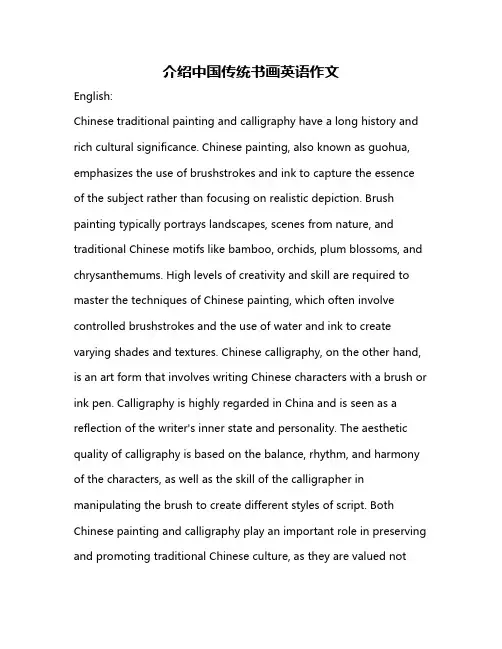
介绍中国传统书画英语作文English:Chinese traditional painting and calligraphy have a long history and rich cultural significance. Chinese painting, also known as guohua, emphasizes the use of brushstrokes and ink to capture the essence of the subject rather than focusing on realistic depiction. Brush painting typically portrays landscapes, scenes from nature, and traditional Chinese motifs like bamboo, orchids, plum blossoms, and chrysanthemums. High levels of creativity and skill are required to master the techniques of Chinese painting, which often involve controlled brushstrokes and the use of water and ink to create varying shades and textures. Chinese calligraphy, on the other hand, is an art form that involves writing Chinese characters with a brush or ink pen. Calligraphy is highly regarded in China and is seen as a reflection of the writer's inner state and personality. The aesthetic quality of calligraphy is based on the balance, rhythm, and harmony of the characters, as well as the skill of the calligrapher in manipulating the brush to create different styles of script. Both Chinese painting and calligraphy play an important role in preserving and promoting traditional Chinese culture, as they are valued notonly for their artistic beauty but also for their historical and cultural significance.Translated content:中国传统书画有着悠久的历史和丰富的文化意义。
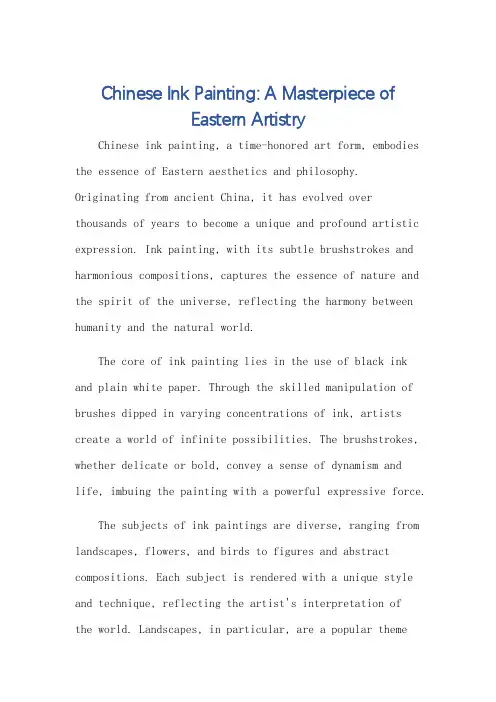
Chinese Ink Painting: A Masterpiece ofEastern ArtistryChinese ink painting, a time-honored art form, embodies the essence of Eastern aesthetics and philosophy.Originating from ancient China, it has evolved over thousands of years to become a unique and profound artistic expression. Ink painting, with its subtle brushstrokes and harmonious compositions, captures the essence of nature and the spirit of the universe, reflecting the harmony between humanity and the natural world.The core of ink painting lies in the use of black ink and plain white paper. Through the skilled manipulation of brushes dipped in varying concentrations of ink, artists create a world of infinite possibilities. The brushstrokes, whether delicate or bold, convey a sense of dynamism and life, imbuing the painting with a powerful expressive force. The subjects of ink paintings are diverse, ranging from landscapes, flowers, and birds to figures and abstract compositions. Each subject is rendered with a unique style and technique, reflecting the artist's interpretation ofthe world. Landscapes, in particular, are a popular themein ink painting. They depict mountains, rivers, and other natural elements with a blend of realism and abstraction, evoking a sense of tranquility and vastness.The use of color in ink painting is sparing and subtle. While black ink is the primary medium, occasional splashes of color, often in the form of seals or inscriptions, add a touch of vibrancy and enhance the overall composition. The balance between black and white, as well as the sparing use of color, creates a sense of harmony and elegance.Moreover, ink painting is not merely a visual art form; it also carries deep cultural and philosophical meanings.It is often seen as a reflection of the artist's inner world, expressing their thoughts and feelings through the brushstrokes and compositions. The simplicity and elegance of ink painting align with the Chinese philosophy of "less is more," emphasizing the beauty of understatement and subtlety.The art of ink painting has also influenced other art forms and cultures throughout Asia and beyond. Its unique style and technique have inspired numerous artists toexplore and innovate, giving rise to a rich and diversebody of work.In conclusion, Chinese ink painting is a masterpiece of Eastern artistry that combines visual beauty with deep cultural and philosophical meanings. Its subtle brushstrokes, harmonious compositions, and sparing use of color create a world of infinite possibilities, reflecting the essence of nature and the spirit of the universe. As an essential part of Chinese culture, ink painting continuesto inspire and captivate art lovers worldwide.**中国水墨画:东方艺术的杰作**中国水墨画,这一历史悠久的艺术形式,体现了东方美学和哲学的精髓。
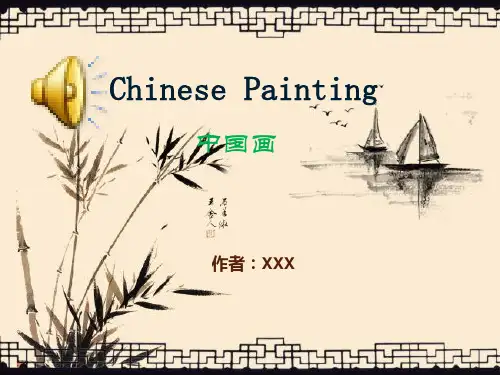
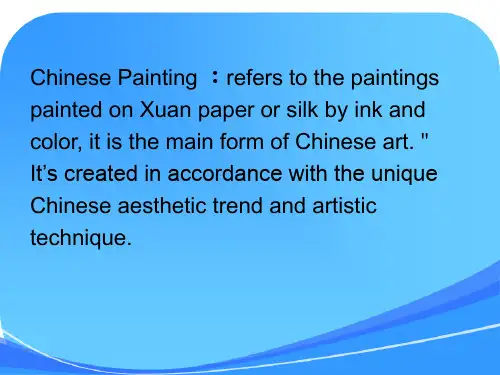
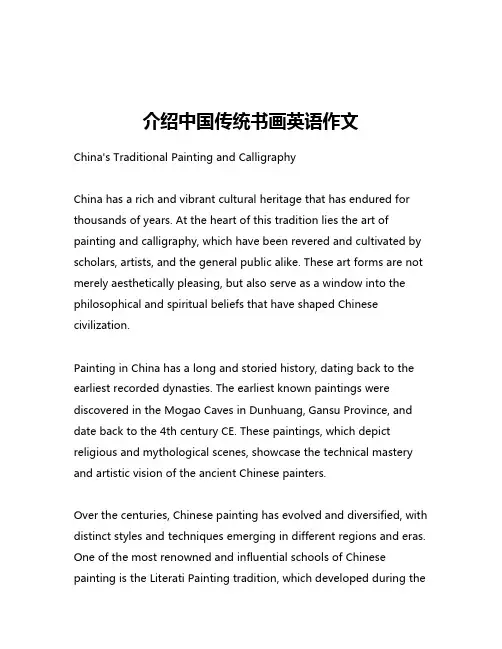
介绍中国传统书画英语作文China's Traditional Painting and CalligraphyChina has a rich and vibrant cultural heritage that has endured for thousands of years. At the heart of this tradition lies the art of painting and calligraphy, which have been revered and cultivated by scholars, artists, and the general public alike. These art forms are not merely aesthetically pleasing, but also serve as a window into the philosophical and spiritual beliefs that have shaped Chinese civilization.Painting in China has a long and storied history, dating back to the earliest recorded dynasties. The earliest known paintings were discovered in the Mogao Caves in Dunhuang, Gansu Province, and date back to the 4th century CE. These paintings, which depict religious and mythological scenes, showcase the technical mastery and artistic vision of the ancient Chinese painters.Over the centuries, Chinese painting has evolved and diversified, with distinct styles and techniques emerging in different regions and eras. One of the most renowned and influential schools of Chinese painting is the Literati Painting tradition, which developed during theSong Dynasty (960-1279 CE). Literati painters, who were often scholar-officials, rejected the highly detailed and realistic styles of court painting in favor of a more expressive and personal approach.The Literati Painters sought to capture the essence of the natural world through the use of bold brushstrokes, subtle shades of ink, and a minimalist aesthetic. They often depicted landscapes, flowers, and birds, imbuing their works with a sense of contemplation and spiritual harmony. The most renowned Literati Painters include Su Shi, Mi Fu, and Zhao Mengfu, whose works are revered for their technical mastery and profound emotional resonance.Alongside painting, the art of calligraphy has also played a central role in Chinese cultural heritage. Calligraphy, the art of beautiful handwriting, is deeply rooted in the Chinese written language and is considered one of the highest forms of artistic expression. Calligraphers use a variety of specialized brushes and inks to create elegant and expressive characters that convey not only the meaning of the words but also the emotional state and artistic vision of the writer.Like painting, Chinese calligraphy has evolved over the centuries, with different styles and techniques emerging in different eras. The most renowned styles include the Seal Script, which dates back to the Qin Dynasty (221-206 BCE), the Clerical Script, which developedduring the Han Dynasty (206 BCE-220 CE), and the Running Script, which became popular during the Tang Dynasty (618-907 CE).One of the most revered calligraphers in Chinese history is Wang Xizhi, who lived during the Jin Dynasty (266-420 CE). His works, which are renowned for their elegance, fluidity, and emotional depth, have become the benchmark by which all other calligraphic works are judged. Other renowned calligraphers include Ouyang Xun, Yan Zhenqing, and Zhao Mengfu, whose works are celebrated for their technical mastery and expressive power.The art of painting and calligraphy in China is not merely a matter of technical skill, but is also deeply intertwined with the philosophical and spiritual beliefs that have shaped Chinese culture. Painters and calligraphers often drew inspiration from Taoist and Confucian teachings, which emphasize the importance of harmony with nature, the cultivation of the self, and the pursuit of spiritual enlightenment.In the Taoist tradition, for example, the act of painting or calligraphy is seen as a form of meditation, a way of achieving a state of transcendent calm and inner peace. The painter or calligrapher seeks to channel the energy of the natural world, to capture the essence of the subject matter, and to express their own emotional and spiritual state through the medium of ink and brush.Similarly, the Confucian emphasis on self-cultivation and moral development is reflected in the art of painting and calligraphy. Scholars and officials were expected to be well-versed in these arts, as they were seen as a means of cultivating one's character and expressing one's moral and intellectual refinement.Today, the art of Chinese painting and calligraphy continues to be celebrated and practiced throughout China and around the world. Artists and enthusiasts continue to study the techniques and styles of the great masters, while also exploring new and innovative ways of expressing the timeless themes and values of Chinese culture.Whether it is the bold and expressive brushstrokes of a Literati landscape, or the elegant and harmonious characters of a calligraphic masterpiece, the art of painting and calligraphy in China remains a testament to the enduring power of human creativity and the enduring spirit of a civilization that has shaped the world.。
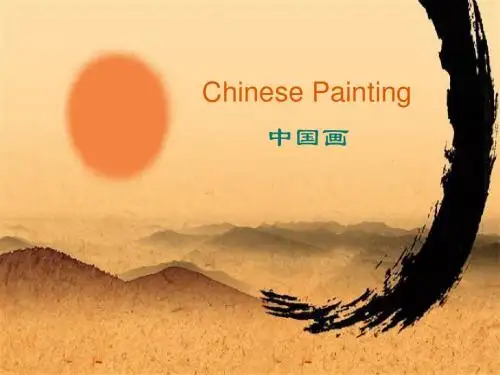
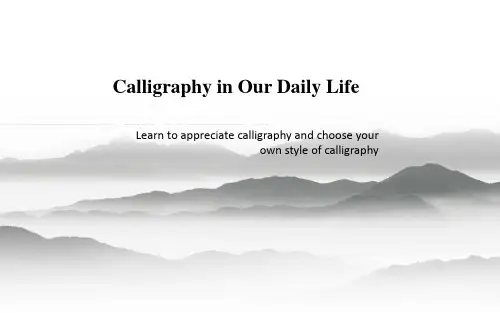
介绍中国传统书画英语作文Traditional Chinese calligraphy and painting are highly esteemed art forms that have been cherished for centuries. Calligraphy, known as "Shufa" in Chinese, involves the skilled use of brush and ink to create intricate characters with aesthetic appeal. The strokes, structure, and balance of the characters convey the artist's emotions and thoughts, making calligraphy a reflection of one's inner self.Chinese painting, or "Shui-mo Hua," typically uses the same brush and ink techniques as calligraphy, but focuses on capturing the beauty of nature, animals, and landscapes. Artists use various brushstrokes and ink washes to depict the harmony and balance of the natural world, often incorporating elements of poetry and philosophy into their works.Both calligraphy and painting are deeply rooted in Chinese culture and history, embodying traditional values such as harmony, balance, and reverence for nature. They serve as a means of artistic expression, meditation, and spiritual reflection, connecting the artist and the viewer to the rich heritage of Chineseart.中文翻译:中国传统书画是被人们珍视数百年的高尚艺术形式。
Chinese Painting: A Glimpse into the Soul of Traditional Chinese Art Chinese painting, known as "Guohua" in Mandarin, is a unique form of visual art that has deep roots in Chinese culture. Unlike Western painting, which focuses on realistic or representational values, Chinese painting emphasizes the expression of the artist's inner feelings and the harmony between humanity and nature. This art form has evolved over thousands of years, reflecting the rich history and philosophical beliefs of the Chinese people.In Chinese painting, artists often use ink and watercolor on silk or paper as their primary mediums. The brush, an essential tool in this art, allows artists to create avariety of strokes and textures, capturing the essence of their subjects with remarkable simplicity. The subjects of Chinese painting range from landscapes and flowers to birds and animals, with each element holding symbolic meanings and conveying the artist's thoughts and emotions.Chinese painting techniques are rich and diverse, with various schools and styles emerging throughout history. Some of the most famous schools include the Literati (Wenren), inkwash (Shuimohua), and BirdandFlower (Huaniao) schools.Each school has its unique characteristics and aesthetic principles, contributing to the rich tapestry of Chinese painting.As you delve into the world of Chinese painting, you will find that it is not just an art form, but a window into the soul of traditional Chinese culture, revealing the values, beliefs, and artistic ideals that have shaped the nation's identity for millennia.Exploring the Depth and Elegance of Chinese Painting TechniquesThe art of Chinese painting is a journey of discovery, where each stroke of the brush tells a story and each color holds a meaning. Beyond the initial impression of beauty, lie layers of symbolism and technical mastery that continue to captivate audiences worldwide.The use of color in Chinese painting is particularly noteworthy. Artists often employ a limited palette, with black, white, and various shades of gray dominating the scene. This monochromatic approach is not a limitation but a deliberate choice to emphasize the elegance and depth of the artwork. When colors are used, they are often symbolic—redfor joy, yellow for prosperity, and blue for tranquility.The brushwork in Chinese painting is an art in itself. Artists train for years to master the different brushtechniques, each yielding a unique effect. The "hard edge" technique creates sharp, defined lines perfect for depicting structures, while the "soft edge" technique allows for more fluid, impressionistic renderings of natural elements like water and mist. The "dripping ink" technique, on the other hand, is used to create textures and suggest the movement of water or the aging process of trees.Composition in Chinese painting is guided the principle of "three distances": foreground, middle ground, and background. This creates a sense of depth and perspectivethat is different from the linear perspective used in Western art. The foreground is often detailed, while the background is more abstract, inviting the viewer to imagine the vastness of the landscape or the expanse of the sky.The spirit of Chinese painting is deeply rooted in the concept of "Chi" or life force. Artists aim to capture the essence of their subjects, to imbue their work with a sense of life and vitality. This is why a simple brushstroke can convey the gentle sway of a bamboo stalk or the playful leap of a fish in a stream.In addition to technical skill, Chinese painting also values the artist's personality and cultural refinement. The Literati school, for example, places great importance on the artist's poetry, calligraphy, and moral character. Theartwork is not just a visual representation but an extension of the artist's inner world.Embracing the Philosophical Dimensions of Chinese PaintingBeyond the intricate brushstrokes and harmonious colors, Chinese painting is a reflection of the philosophical and spiritual beliefs that have shaped Chinese culture for centuries. It is an art form that not only pleases the eye but also engages the mind and spirit.The philosophy of Taoism, with its emphasis on thenatural world and the flow of life, is deeply embedded in Chinese painting. Artists often seek to capture the essence of Taoist principles such as simplicity, spontaneity, and the pursuit of harmony with nature. This is evident in the way they depict landscapes, often with an absence of human figures, allowing the viewer to immerse themselves in the serene and untouched beauty of the natural world.The act of painting itself is a meditative process for many Chinese artists. It requires a clear mind and a tranquil heart, allowing the artist to connect with the subject and the medium in a deeply personal way. The resulting artwork is not just a product of skill but a manifestation of theartist's inner peace and contemplation.In Chinese painting, the importance of calligraphy cannot be overstated. The flowing lines of calligraphy are often integrated into the painting, serving both as text and as an artistic element. The style and quality of the calligraphy reflect the artist's character and cultural attainment, adding another layer of meaning to the artwork.Moreover, Chinese painting is a celebration of the seasons and the cycles of life. Artists frequently depict scenes that correspond to the four seasons, each imbued with its own emotions and symbols. Spring is often represented with blossoming flowers and new growth, summer with lush foliage and vibrant colors, autumn with harvest scenes and golden hues, and winter with barren landscapes and the quiet beauty of snow.。
中国画介绍英文版Chinese painting is one of the oldest and most highly esteemed art forms in China. Spanning thousands of years, it has evolved and developed into a unique style that reflects the country's rich cultural heritage. Chinese painting is known for its meticulous brushwork, vibrant colors, use of space, and emphasis on the essence of the subject. It incorporates various techniques, including ink wash painting, meticulous painting, and freehand brushwork, creating a diverse and captivating art form with deep cultural meanings.Ink wash painting, also known as shui-mo hua, is atraditional style of Chinese painting that originated in ancient China. It utilizes water and ink on rice paper to createdelicate and expressive images. The artist uses different shades of ink to depict the subject, often landscapes, flowers, or animals. This technique requires precision and control, as the artist must carefully control the amount of water and ink used to create different effects. The strokes are often fast and spontaneous, reflecting the artist's emotions and capturing the essence of the subject.Meticulous painting, or gong-bi hua, is another style of Chinese painting characterized by intricate details and fine brushwork. It often depicts people, historical figures, or scenes from mythology. The artist meticulously outlines thesubject in ink and then fills in the colors using mineral pigments. This technique requires meticulous skill and patience, as the artist must apply layers of color to create depth and texture. The result is a highly realistic and detailed painting that showcases the artist's technical proficiency.Freehand brushwork, or xie-yi hua, is a more expressive and spontaneous style of Chinese painting. It involves using quick and bold brushstrokes to depict the subject, often landscapes or birds and flowers. The artist relies on intuition and creativity to convey the subject's essence, rather than focusing onintricate details. This style of painting allows for more experimentation and freedom, capturing the artist's emotions and spontaneity in each brushstroke.Chinese painting has been influential not only within China but also in the larger art world. Its unique style and techniques have inspired many artists around the world, who have incorporated Chinese painting elements into their own works. The delicate brushwork, vibrant colors, and deep cultural meanings make Chinese painting a truly captivating and enduring art form.。
中国传统艺术形式书画英语作文【英文版】The Artistry and Cultural Legacy of Chinese Calligraphy and PaintingCalligraphy and painting, two of the most prominent forms of traditional Chinese art, have captivated audiences for centuries. These two disciplines, often considered as a single art form, are deeply rooted in Chinese culture and history. Through their unique techniques and expressive styles, calligraphers and painters convey messages that transcend time and space, evoking emotions and fostering a sense of connection with the viewer.In calligraphy, the artist’s mastery of brushwork and ink application creates a range of expressions that convey a myriad of meanings. From elegant cursive script to bold, geometric patterns, calligraphy’s diverse styles reflect the artist’s personal tastes and cultural context. The fluid strokes of a skilled calligrapher capture the essence of timelessness, creating works that inspire contemplation and awe.In contrast, traditional Chinese painting relies on color, texture,and composition to convey a narrative or emotional message. Paintings often depict natural landscapes, historical scenes, or abstract patterns that serve as symbols of cultural values and beliefs. Through the use of various media such as silk, rice paper, and brushes, the painter evokes a sense of serenity or drama, reflecting the harmony or discord inherent in human experience. The fusion of calligraphy and painting into a single art form is evident in works such as scrolls, where the two disciplines complement each other to create a seamless narrative. The artistic value of these works is not limited to their aesthetic appeal, but also extends to their cultural significance as symbols of tradition and heritage.Calligraphy and painting serve as an indispensable aspect of Chinese culture, not only aesthetically pleasing but also reflecting social norms, values, and beliefs. As China’s rich cultural heritage continues to thrive and evolve, these traditional forms of art will undoubtedly remain an integral part of the nation’s artistic legacy.【中文版】书法与绘画的艺术魅力与文化传承书法与绘画,作为中国传统艺术形式,几个世纪以来一直吸引着观众。
关于中国书画的英语作文Chinese calligraphy and painting are ancient art forms that have a rich history and cultural significance. These art forms have evolved over thousands of years, reflecting the unique aesthetic sensibilities and philosophical traditions of the Chinese people. In this essay, we will explore the origins, characteristics, and cultural significance of Chinese calligraphy and painting.Chinese calligraphy is the art of beautiful handwriting, and it is considered one of the highest forms of artistic expression in China. Calligraphy is not merely a means of written communication but a reflection of the calligrapher's inner state, personality, and artistic sensibilities. The practice of calligraphy requires a deep understanding of the structure and rhythm of Chinese characters, as well as a mastery of brush techniques and the use of ink and paper.The origins of Chinese calligraphy can be traced back to the development of the Chinese writing system, which is believed to have emerged around the 3rd millennium BCE. Early forms of Chinese writing were carved onto oracle bones, turtle shells, andbronze vessels, and these early scripts were characterized by their angular and structured forms. Over time, the script evolved, becoming more fluid and expressive, as calligraphers experimented with different brushstrokes and ink techniques.One of the most important aspects of Chinese calligraphy is the concept of qi, which refers to the vital energy or life force that is believed to be present in all things. Calligraphers strive to capture the essence of qi in their work, using the movement of the brush to convey a sense of energy and dynamism. The calligrapher's personal style and emotional state are also reflected in the work, as the brushstrokes and the flow of the ink on the paper are seen as a direct expression of the artist's inner world.Chinese painting, on the other hand, is a visual art form that has a long and rich history. Like calligraphy, Chinese painting is not merely a representation of the physical world but a reflection of the artist's spiritual and emotional state. Chinese painting is often divided into two main categories: landscape painting (shanshui) and figure painting (renwu).Landscape painting is a particularly important and revered form of Chinese art, and it is often seen as a reflection of the artist's relationship with nature. Landscape paintings typically depict scenes of mountains, rivers, forests, and other natural elements, but they arenot intended to be mere realistic representations. Instead, the artist seeks to capture the essence of the landscape, conveying a sense of the underlying energy and harmony that permeates the natural world.One of the most important principles of Chinese landscape painting is the concept of "empty space" (bai). In Chinese painting, the empty spaces between the painted elements are just as important as the painted elements themselves, as they allow the viewer to engage with the work on a deeper level and to project their own interpretations and emotions onto the painting.Figure painting, on the other hand, focuses on the depiction of human subjects, often in the form of portraits or scenes of daily life. Figure painting in China has a long and distinguished history, and it has been used to capture the essence of the human experience, from the grandeur of imperial court life to the simple pleasures of everyday existence.Like calligraphy, Chinese painting is characterized by a deep respect for the materials and techniques used in its creation. Painters use a variety of brushes, inks, and paper, each of which has its own unique properties and expressive potential. The use of color in Chinese painting is also highly symbolic, with different colors representing different emotional states, natural phenomena, or culturalassociations.One of the most distinctive features of Chinese painting is the use of the "boneless" style, which eschews the use of outlines and instead relies on the manipulation of ink and brush to create a sense of form and depth. This style is often associated with the literati painters of the Song and Yuan dynasties, who sought to imbue their works with a sense of spontaneity and emotional resonance.In addition to their aesthetic and technical merits, Chinese calligraphy and painting are also deeply rooted in the philosophical and cultural traditions of China. The practice of these art forms is often seen as a means of cultivating the self, as the process of creating a work of art is believed to be a form of meditation and self-reflection.The cultural significance of Chinese calligraphy and painting extends beyond the boundaries of the art world, as these art forms have played a crucial role in the development of Chinese literature, philosophy, and even politics. Calligraphic works have been used as a means of political and social commentary, while landscape paintings have been used to express the artist's relationship with the natural world and their place within the broader cosmos.In conclusion, Chinese calligraphy and painting are art forms thathave a rich history and cultural significance. These art forms reflect the unique aesthetic sensibilities and philosophical traditions of the Chinese people, and they continue to be highly valued and studied around the world. Whether one is appreciating the fluid brushstrokes of a calligraphic work or the serene landscapes of a Chinese painting, the experience is one of profound beauty, cultural richness, and deep spiritual resonance.。